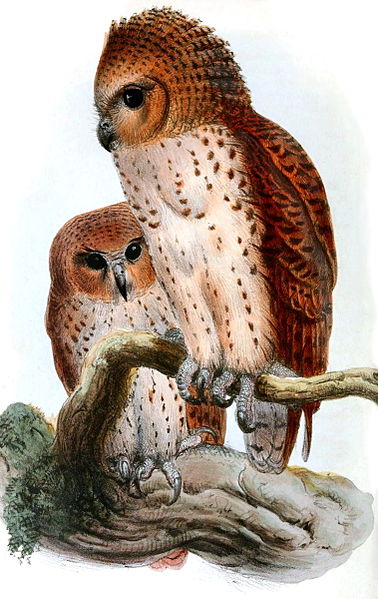 Today I’d like to my shift focus from pet trade birds and introduce you to a species I’ve worked with for many years, the Pel’s Fishing Owl, Scotopelia peli. One individual under my care at the Bronx Zoo lived into his 50’s, and provided me with insights into the owl-world’s most uniquely adapted predator.
Today I’d like to my shift focus from pet trade birds and introduce you to a species I’ve worked with for many years, the Pel’s Fishing Owl, Scotopelia peli. One individual under my care at the Bronx Zoo lived into his 50’s, and provided me with insights into the owl-world’s most uniquely adapted predator.
Owl Diversity: Bug Hunters to Deer-Slayers
It seems that the various species of owls are viewed by most folks as “variations on a theme” – mysterious, nocturnal birds that feed upon rodents and vanish by day. But within the owl family (Strigiformes) we find an incredible diversity of lifestyles – sparrow-sized Elf Owls that nest in cacti and hunt insects, Great Horned Owls that stalk cats in NYC and parrots in Costa Rica, massive Eagle Owls capable of taking deer fawns, day-flying Hawk Owls…the list goes on. Among the most unique are those that specialize in hunting fishes, known collectively as Fish or Fishing Owls.
I first made their acquaintance when I began working at the Bronx Zoo. As a licensed wildlife rehabilitator, I had previously cared for injured and abandoned Barn, Great Horned, Saw Whet and Screech Owls, but Fishing Owls opened a whole new field of interest for me.
Fishing Owl Natural History
The Fishing Owl’s unique diet has fostered new (in the owl world) adaptations, and they have shed others that are not needed. Unlike other owls, their legs and toes are un-feathered (so as to dry faster) and  spiked scales, which aid in grasping slippery fishes, line the undersides of the toes. Typical owls hear very well, and their flight feathers have soft edges that muffle sound…we do not find these adaptations in Fishing Owls, as fishes and Fishing Owls cannot hear one another.
spiked scales, which aid in grasping slippery fishes, line the undersides of the toes. Typical owls hear very well, and their flight feathers have soft edges that muffle sound…we do not find these adaptations in Fishing Owls, as fishes and Fishing Owls cannot hear one another.
The Pel’s Fishing Owl, Africa’s largest, occupies a huge range stretching from Senegal in the west clear across the continent to Somalia and south to Namibia and South Africa. It is, however, threatened by dams (which impact fish populations), commercial fishing and the loss of the hollow-bearing trees in which it nests.
The Pel’s Fishing Owl is listed on CITES Appendix II and is considered critically endangered in Namibia and vulnerable in South Africa.
Fishing Frigid Waters
Other Fishing Owls are more limited in distribution, and likely highly endangered. The huge Blakiston’s Fishing Owl, Ketupa blakistoni, for example, is restricted to Siberia, northeastern China and Hokkaido, in northern Japan (please see photo). Supplementary feeding and nest-box installation helps the tiny Japanese population hold on, but its prospects are bleak elsewhere.
Stealing Fish for my Favorite Owl
The Pel’s Fishing Owl mentioned in the introduction above was about 30 years old when I made his acquaintance, and had been living on a diet of mice for most of that time (please see drawing). While mice provided all the nutrition he needed, I couldn’t resist adding a bit of variety.
 I began pilfering live trout from the Reptile Department (this expensive food item was reserved for the rare crocodilians known as Gharials, so I operated in secrecy at first). His enthusiastic reaction encouraged me, and soon fresh fish and crayfishes were added to his “official” diet (wild Fishing Owls also take frogs, large insects, crabs, small snakes and hatchling crocodiles).
I began pilfering live trout from the Reptile Department (this expensive food item was reserved for the rare crocodilians known as Gharials, so I operated in secrecy at first). His enthusiastic reaction encouraged me, and soon fresh fish and crayfishes were added to his “official” diet (wild Fishing Owls also take frogs, large insects, crabs, small snakes and hatchling crocodiles).
Further Reading
Excellent Video: Blakiston’s Fishing Owl hunting
Great Horned Owl: Encounters in Nature and Captivity
Pel’s Fishing Owl Natural History
Brown’s Fishing Owl image referenced from wikipedia and originally posted by Dr. Tarak N Khan
Blakiston’s Fishing Owl image referenced from wikipedia and originally posted by MIKI
 That Bird Blog – Bird Care and History for Pet Birds
That Bird Blog – Bird Care and History for Pet Birds




i’m amazed to see something new, fishing owls!..are there any fishing owls on the west usa?…has any t.v. documentry been produced of you and your owl friends?
Hello Debra, Frank Indiviglio here.
Thanks for your interest in our blog; glad you enjoyed. Fishing owls are found only in Asia and Africa; Great Grey and Great horned Owls in the US will take fish when easily available, i.e dead salmon, shad, but have no special adaptations. Almost nothing has been done in the way of filming; but there is a wonderful segment on the Blakiston’s Fishing Owl in the show “Wild Russia” – one of a kind footage. You can view it here.
Please let me know if you need any further information. Good luck, enjoy and please keep me posted.
Best regards, Frank Indiviglio.